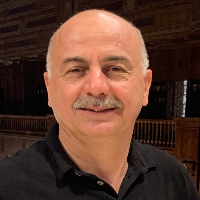Study of Seismic Behaviour in Steel Structures by Using of Combination Braces of Steel and SMA
Author(s):
Abstract:
1.
Introduction
Shape memory alloys (SMA) have found various applications in structural engineering such as active, semi active and passive control due to its characteristics such as high damping capacity, durability, resistance to fatigue and corrosion and its unique characteristics such as shape memory and superelasticity [1]. One of the most important and effective applications of SMA in civil engineering is using these materials as braces, because of the superelastic and shape memory properties of SMA. They have the ability to re-center the original state and to provide high energy dissipation. However, most of the researches about the use of shape memory alloys in structural engineering are in theory level and few of them are experimental.2. Methodology
For the comparison of models, a three-story structure has been used which was proposed by Sabelli. Assuming symmetry in the plan, only a two-dimensional frame of the structure has been analyzed. The height of each floor is 3.96 m and the construction plan is 9.14 in 9.14 m. Ceilings of the floors are composite that the height of the steel part is 76 mm and the height of concrete cover is 50 mm. It is noteworthy that the axial deformation of the beam is ignored [2].The models used for this study are in such a way that bracings, a combination of steel and SMA, have the consumption of 0, 20, 40, 60, 80 and 100 percent respectively in which the first model is the model of steel brace and the last one is the model of SMA brace. A schematic of the bracing is shown in Fig. 1. 3. Results And Discussion
There are two major differences between the behaviors of steel and SMA both of which are introduced as the special properties of shape memory alloys. One of the properties is that this alloy is able to return to its primary state after bearing a large strain; in other words, to minimize the horizontal displacement of the structure; and the other one is that it increases the strain energy in the structure. This section has attempted to provide the most optimum brace through comparing the graphs of the history of horizontal displacement and diagram of structural strain energy in all models, both in terms of SMA consumption and seismic behavior.Table 1. The comparison of the residual displacement of structure in the used bracing systems under the maximum acceleration of 0.6gResidual displacement of structure (mm) Considered model5.31 Bracing system SMA 0% and steel 100%1.46 Bracing system SMA 20% and steel 80%1.10 Bracing system SMA 40% and steel 60%0.93 Bracing system SMA 60% and steel 40%0.85 Bracing system SMA 80% and steel 20%0.84 Bracing system SMA 100% and steel 0%The use of SMA, resistant to earthquakes which has a maximum acceleration of 0.6g, has not a significant difference with steel and utilizing them is not economically justifiable since the entire capacity of the SMA is not properly used. To have a better understanding, hysteresis graph of steel and SMA bracings under maximum acceleration of 0.6g is shown in figs. 3 and 4, respectively. According to fig. (5), it is observable that in the presented models, an increase in SMA consumption increases the value of energy absorption and an increase in the intensity of earthquakes (from 0.6g to 0.9g) indicates this result more clearly. The main reason is due to the special properties of SMA. It means that the return of the structure to its primary state after unloading and resistance against fatigue both cause the hysteresis loops of SMA to be bigger than that of steel and it shows the higher ability of SMA in structure controlling and better energy dampering.To have a better comparison, figs. 6 and 7 show hysteresis graphs of SMA braces and steel braces under maximum acceleration of 0.9g. 4. Conclusions
The performances of bracing containing 20, 40, 60, 80 and 100% of shape memory alloy and steel bracing have been studied. The seismic response of the braced frames are determined and compared to the braced frame with steel brace. The results indicate that the most suitable location for putting shape memory alloy is the ends of bracing. Also, the secondary moment which is produced in bracing at the connection with gusset plate has transmitted better by shape memory alloy than steel. The total capacity of these alloys is not used in records with maximum acceleration of 0.6g and there is no difference between the behavior of steel brace and alloyed brace. Therefore, it is not necessary to use alloyed brace in low-intensity of earthquake due to economic considerations. It is observed that using 20% SMA in the alloyed brace improves 54% in seismic performance by 54% while by using 100% SMA, the amount of improvement is 94% It is concluded that the application of bracing which contains 20% SMA, leads to the improvement of seismic performance without considerable increase in constructional cost.Keywords:
Language:
Persian
Published:
Journal of Civil and Environmental Engineering University of Tabriz, Volume:43 Issue: 3, 2013
Page:
11
magiran.com/p1209306
دانلود و مطالعه متن این مقاله با یکی از روشهای زیر امکان پذیر است:
اشتراک شخصی
با عضویت و پرداخت آنلاین حق اشتراک یکساله به مبلغ 1,390,000ريال میتوانید 70 عنوان مطلب دانلود کنید!
اشتراک سازمانی
به کتابخانه دانشگاه یا محل کار خود پیشنهاد کنید تا اشتراک سازمانی این پایگاه را برای دسترسی نامحدود همه کاربران به متن مطالب تهیه نمایند!
توجه!
- حق عضویت دریافتی صرف حمایت از نشریات عضو و نگهداری، تکمیل و توسعه مگیران میشود.
- پرداخت حق اشتراک و دانلود مقالات اجازه بازنشر آن در سایر رسانههای چاپی و دیجیتال را به کاربر نمیدهد.
In order to view content subscription is required
Personal subscription
Subscribe magiran.com for 70 € euros via PayPal and download 70 articles during a year.
Organization subscription
Please contact us to subscribe your university or library for unlimited access!



